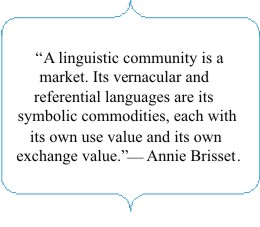Translations as Stimulants of Language
Annie Brisset points out how translations can also stimulate the growth and devel opment of languages. This is not to say that they are capable of generating new languages, but that theycan shape and help evolve a language that is in its nascent form. Martin Luther's translation of the Bible into German rendered such a service to the German language. This is also true of various Indian language translations of the epics. It helped to hone the rough contours of many languages that were in their infancy. opment of languages. This is not to say that they are capable of generating new languages, but that theycan shape and help evolve a language that is in its nascent form. Martin Luther's translation of the Bible into German rendered such a service to the German language. This is also true of various Indian language translations of the epics. It helped to hone the rough contours of many languages that were in their infancy.
Brisset distinguishes between four broad areas of languages:
Vernacular – a language that is spoken locally and spontaneously for communing rather than communication; this can be considered the mother-tongue
Vehicular – a national or regional language learned for the purpose of communication
Referential – language that is tied up with the cultural traditions of a society
Mythical – a language that is largely incomprehensible as it is the language of the sacred texts
In a country with a bewildering array of linguistic variety like India, all these categories exist. The vernacular can be Gujarati and even there it could be a particular regional/dialectical form of the language. If the vernacular is a dialect, the vehicular language can be the accepted or officially recognized form of Gujarati or Hindi. In the context of India this can also be considered to be English. The referential language can be any one of these three and the mythical language can be Sanskrit. A translator has to decide the linguistic register into which s/he wishes to translate. Brisset says that the task of the translation is to replace the language of the “Other" by a native language ( Venuti, 346). Since your language is also a marker of identity, translation also becomes an act of assertion or reclamation of identity. |